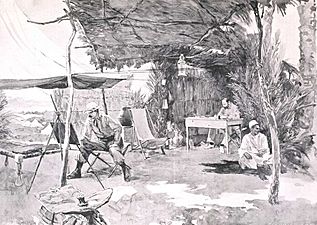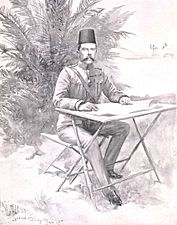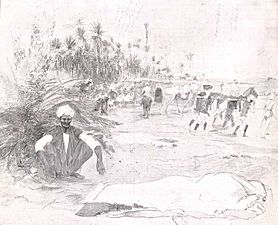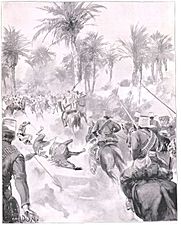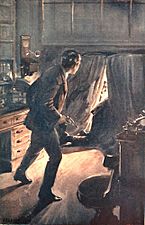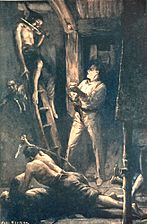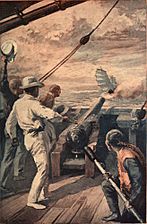Charles Mills Sheldon facts for kids
Charles Mills Sheldon (born June 24, 1866 – died March 14, 1928) was a talented artist and writer. He was born in the United States but moved to Europe in 1890. Charles Sheldon became famous for his drawings and stories from wars, working as a war correspondent and illustrator. He also drew pictures for many adventure books.
| Top - 0-9 A B C D E F G H I J K L M N O P Q R S T U V W X Y Z |
Growing Up and Learning About Art
Charles Sheldon was born in Lawrenceburg, Indiana, on June 24, 1866. His parents were George Wilbur Sheldon and Jeanette Mills. He went to public schools in Lawrenceburg and Des Moines.
When he was 14, he lived with his family in Des Moines, Iowa. After finishing school, Charles began his journey as an artist.
Sheldon's Creative Work
Charles Sheldon started his career by traveling around the southern United States. He drew pictures for articles published by the Associated Press in 1889. Later, he moved to Paris, France, to study art at a famous school called the Académie Julian. There, he learned from well-known artists like Jean-Joseph Benjamin-Constant and Jules Joseph Lefebvre.
From Paris, he sent his illustrations to magazines like the Pall Mall Budget. He also drew for many other popular magazines, including:
- The Ludgate Monthly
- The Strand Magazine
- Black and White
- Frank Leslie's Illustrated Newspaper
- The Royal Magazine
Reporting from War Zones
Charles Sheldon became a war correspondent, which meant he traveled to places where wars were happening to draw and report on them. He worked for Black and White magazine and later for Leslie's. He covered several conflicts, showing how quickly he could get ready for a trip.
- The Jameson Raid (1895-1896): When he got the news about this event, he packed and left in just 17 minutes! Even though the raid was over by the time he arrived, he still sent back interesting reports, like a large picture of a gold mine.
- The Sudan Campaign (1886): He had only three hours to pack for this trip! He drew many pictures of the British army's actions in Sudan. At this time, photography was becoming more popular. Magazines sometimes changed his sketches to look more like photos.
- The Spanish-American War (1898): Charles traveled to Cuba to cover this war. By this point, he was also sending photographs along with his drawings.
- The Second Boer War (1899 onwards): He reported from South Africa during this conflict.
- The Delhi Durbar (1903): He went to India for a big celebration called the Delhi Durbar. His son later gave 156 photographs that Charles took there to the India Office Library.
Illustrations from the Sudan Campaign
These pictures were drawn by Charles Sheldon when he was a war correspondent for Black and White magazine. They show scenes from Kitchener's campaign in the Anglo-Egyptian conquest of Sudan.
Drawing for Books
Charles Sheldon also illustrated many books, especially adventure stories for boys. His drawings often showed exciting scenes of fighting and conflict. Here are some of the books he illustrated:
- 1886: True to the Old Flag: A Tale of the American War of Independence by G. A. Henty
- 1899: Won by the Sword: A Tale of the Thirty Years' War by G.A. Henty
- 1900: In the Irish Brigade: A Tale of War in Flanders and Spain by G.A. Henty
- 1902: To Herat and Cabul, A Story of the First Afghan War by G.A. Henty
- 1903: In the grip of the mullah: A tale of adventure in Somaliland by Frederick Sadleir Brereton
- 1904: Tom Burnaby: A story of Uganda and the great Congo forest by Herbert Strang
- 1907: On the Trail of the Arabs: A Story of Heroic Deeds in Africa by Herbert Strang
- 1910: John Bargreave's Gold. A tale of adventures in the Caribbean by F.S. Brereton
- 1912: Under the Chinese dragon: A tale of Mongolia. by F.S. Brereton
- 1912: Captured at Tripoli: A tale of adventure by Percy F. Westerman
- 1914: Pioneers in Tropical America by Harry Johnston
- 1915: A sturdy young Canadian by Frederick Sadleir Brereton
Examples of Book Illustrations
These illustrations were drawn by Charles Sheldon for the book Under the Chinese dragon: A tale of Mongolia by F.S. Brereton.
Family Life
Charles Sheldon married Grace Mary Garland on November 26, 1896, at St George Hanover Square in London. Grace was a childhood friend. Charles had just returned from his work as a war correspondent in Sudan. Grace's father, Eugene Fitch, was an inventor who created an early mechanical digital clock.
Charles and Grace had two children:
- Grace Jeanette Sheldon (born 1899)
- Eugene Fitch Mills Sheldon (born 1905)
In 1901, the family lived at 3 Bath Road in Chiswick, London. Charles continued to live in Chiswick for many years.
Later Years and Legacy
Charles Mills Sheldon passed away on March 14, 1928, at Chiswick Hospital in London. He was living at 45a Fairfax Road in Bedford Park, Chiswick, at the time.
It's important to know that there was another famous person named Charles Sheldon, a Reverend Charles Monroe Sheldon. People sometimes confuse their work, but Charles Mills Sheldon was the artist and war correspondent.



